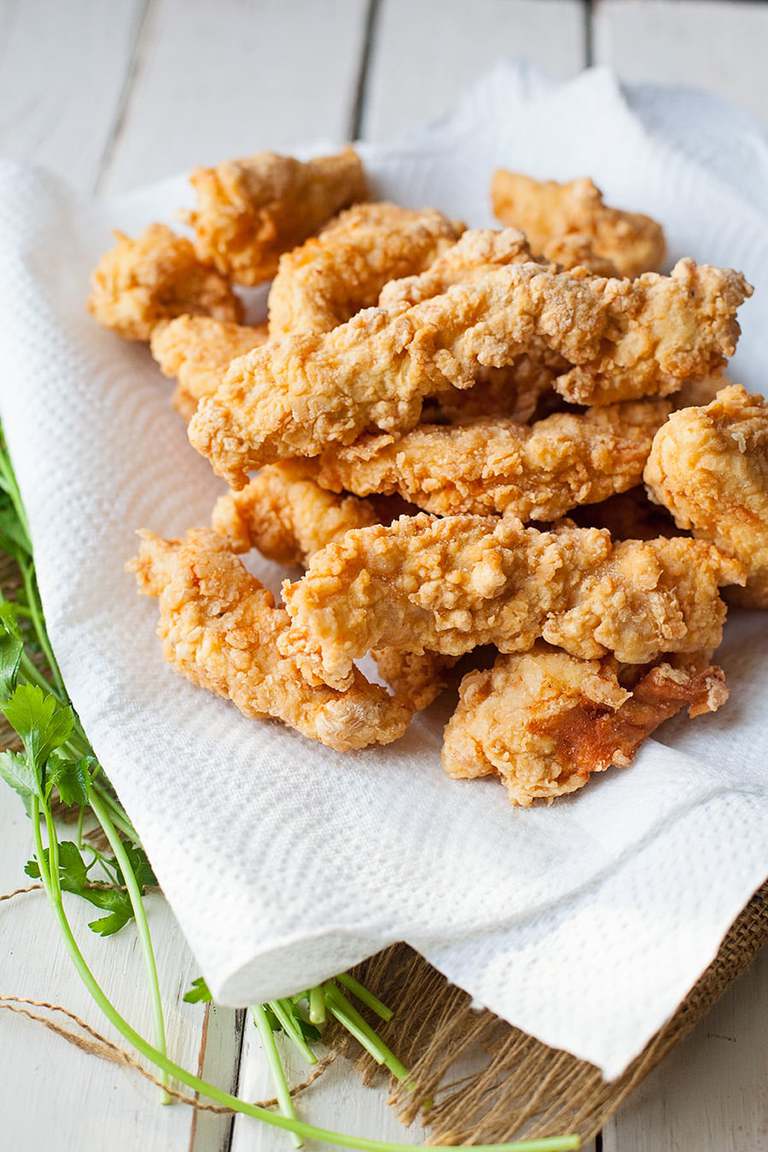Try the easiest chicken strips recipe ever! Ideal for busy weeknights, these crispy fried chicken strips will become a family favorite in no time. With just a few simple ingredients and quick steps, you’ll be enjoying golden, extra-crunchy chicken in a flash. Don’t believe us? Give it a go and see for yourself!
EQUIPMENT
- 2 medium mixing bowls
- Sharp kitchen knife
- Wire whisk
- Meat tenderizer
- Large slotted spoon or spider skimmer
- Paper towels
- Heavy-bottomed pot
INGREDIENTS
- 3-4 large boneless, skinless chicken breasts
- 2 cups all-purpose flour
- 2 tsp baking powder
- 1 tbsp garlic powder
- ½ tsp onion powder
- 1 tsp seasoned salt
- 3 tsp poultry seasoning
- ½ tsp pepper
- 5 large eggs
- ¼ cup milk (2% or whole)
- Canola or vegetable oil for frying

INSTRUCTIONS
- In a medium bowl, whisk together eggs and milk until well combined.
- In another medium bowl, mix flour, baking powder, garlic powder, onion powder, seasoned salt, poultry seasoning, and pepper.
- Use a meat mallet to pound each chicken breast thin. Then, cut the chicken breasts into strips or nuggets.
- Heat the oil in a heavy-bottomed pot over medium heat. The oil is ready when a pinch of the flour mixture sizzles when dropped in.
- While the oil heats, dip each chicken strip into the egg mixture, ensuring a thick coat.
- Coat each strip in the flour mixture, pressing lightly to ensure a good coverage. For extra crispiness, dip the strips back into the egg mixture and then back into the flour.
- Once the oil is heated, add 3-4 chicken strips at a time to the pot, making sure not to overcrowd. Fry for 60-90 seconds on one side without touching the strips to allow the batter to set.
- Flip the strips and cook for another 5 minutes or until both sides are golden brown and the chicken is fully cooked.
- Remove the strips and drain on paper towels. Serve hot.
NOTES
- You can substitute self-rising flour for all-purpose flour. If using self-rising flour, skip the baking powder.
- The nutrition information is auto-calculated and may vary. Adjust for your specific dietary needs.
- Leftover chicken strips can be frozen for up to 3 months. Let them cool completely before freezing in freezer bags. To reheat, cook from frozen.
Nutrition (per 2 chicken strips):
- Calories: 261 kcal
- Carbohydrates: 39g
- Protein: 16g
- Fat: 4g
- Saturated Fat: 1g
- Polyunsaturated Fat: 1g
- Monounsaturated Fat: 1g
- Trans Fat: 0.01g
- Cholesterol: 115mg
- Sodium: 375mg
- Potassium: 251mg
- Fiber: 2g
- Sugar: 1g
- Vitamin A: 196 IU
- Vitamin C: 1mg
- Calcium: 105mg
- Iron: 3mg





